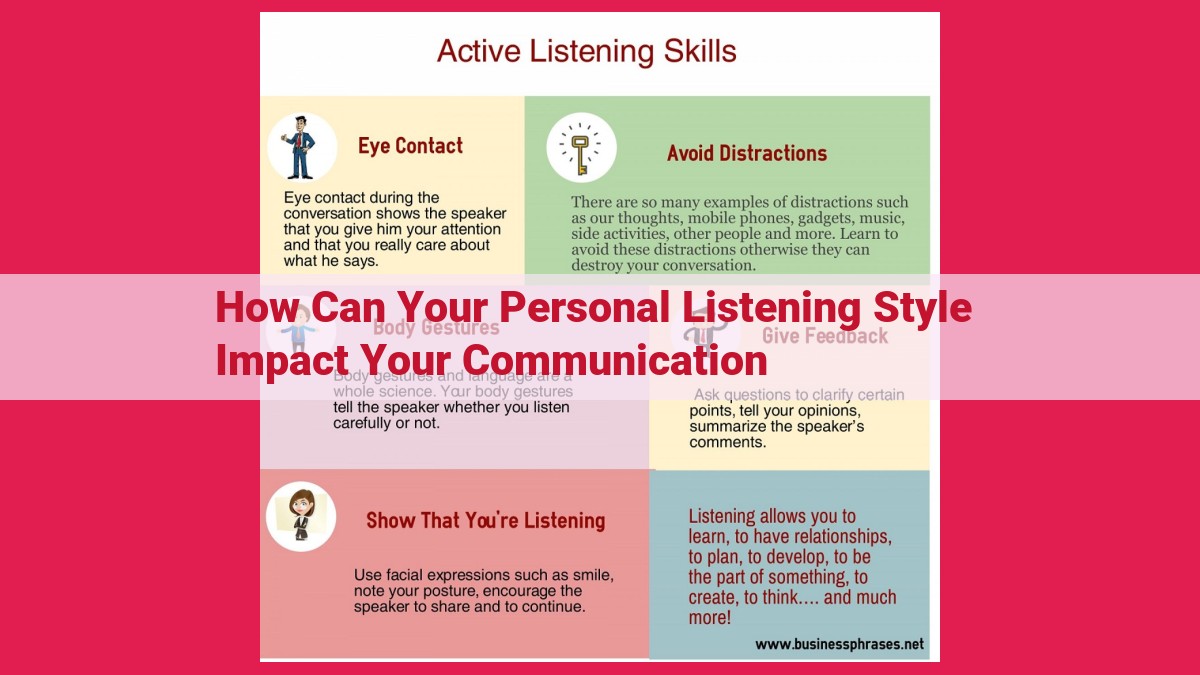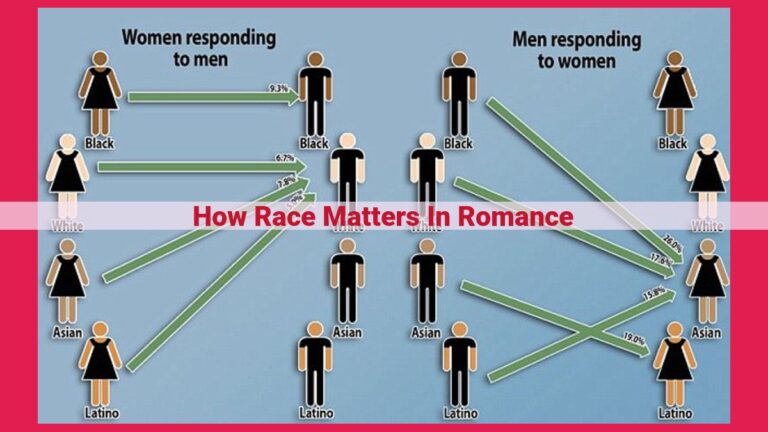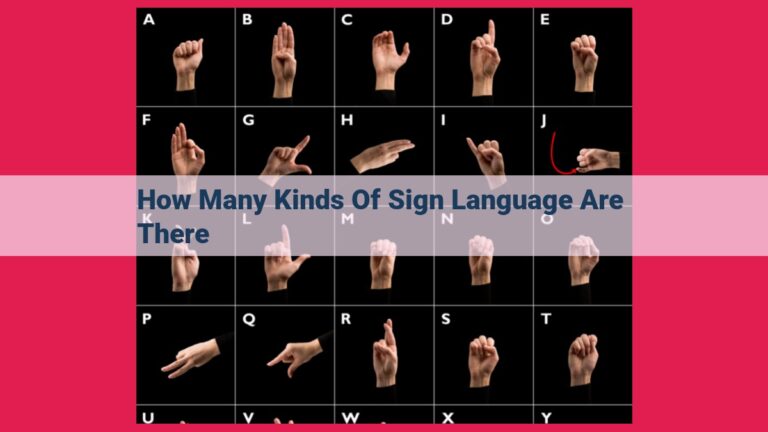Mastering Listening Styles For Enhanced Communication In The Digital Age

Your personal listening style greatly impacts your communication. Active listening involves paying attention, clarifying, and asking questions to ensure understanding. Reflective listening builds on this by restating what is heard, fostering a supportive environment. Empathetic listening allows you to connect on an emotional level, while critical listening enables you to analyze and evaluate objectively. Selective listening helps focus on relevant information, while defensive and interruptive listening can hinder communication. Multitasking can divide attention and prevent complete understanding. Improving your listening style involves practicing active and empathetic listening, avoiding defensive and interruptive behaviors, and increasing your focus.
Mastering the Art of Active Listening: A Guide to Effective Communication
In a world where communication has become increasingly instant and fragmented, the art of truly listening has become more important than ever. Active listening, the ability to fully engage with a speaker and understand their message on multiple levels, is a crucial skill for fostering meaningful connections and driving successful outcomes.
Understanding Active Listening
Active listening goes beyond simply hearing words. It involves paying undivided attention, actively clarifying what is said, and asking questions to deepen understanding. This intentional approach allows you to not only grasp the literal meaning of the message but also its underlying emotions and intentions.
By engaging in active listening, you demonstrate respect for the speaker and show that you value their thoughts and feelings. It creates a safe and supportive environment where open and honest communication can flourish.
The Power of Reflective Listening: Building on Active Listening
In the tapestry of communication, listening stands as a cornerstone, weaving connections and bridging understanding. Among the various listening techniques, reflective listening emerges as a transformative force, amplifying the power of active listening and fostering a profound sense of support.
Reflective listening transcends the mere comprehension of words; it delves into the realm of restatement, where the listener becomes an echo of the speaker’s thoughts, feelings, and experiences. By mirroring the speaker’s words, pausing to clarify, and using phrases like “Let me see if I understand correctly…”, the reflective listener creates a safe and supportive environment where ideas can flourish and emotions can be expressed freely.
This process of reflection serves multiple purposes. It allows the speaker to confirm that their message has been accurately received, reducing the risk of misunderstandings and misinterpretations. It also demonstrates genuine engagement and empathy, conveying to the speaker that their perspectives are valued.
Furthermore, reflective listening provides a therapeutic space for individuals to explore their own thoughts and feelings. By externalizing their internal narrative, speakers gain a new perspective and a deeper understanding of their own experiences. The reflective listener becomes a facilitator, guiding the speaker toward self-discovery and emotional growth.
In the symphony of communication, reflective listening is a gentle melody that harmonizes different viewpoints, fosters deeper connections, and empowers individuals to navigate the complexities of human interaction. Its power lies in its ability to validate, support, and transform, leaving a lasting imprint on both the speaker and the listener.
Empathetic Listening: Connecting on an Emotional Level
In the realm of communication, empathetic listening stands out as a powerful tool that transcends mere words. It’s a bridge that connects us to the emotional depths of others, fostering a profound understanding and connection.
The Essence of Empathy
Empathetic listening involves stepping into the shoes of another, seeking to feel their joys, sorrows, and fears as if they were our own. It’s about acknowledging and validating the emotions being expressed, rather than simply focusing on the content of the message.
Mirroring Words and Feelings
To engage in empathetic listening, mirror the speaker’s words and feelings through your body language, tone, and facial expressions. Nod, make eye contact, and use affirmative gestures to show that you’re with them. When appropriate, use phrases like, “I understand how you’re feeling” or “It sounds like you’re really disappointed.”
Creating a Safe Space
Creating a safe space for the speaker is paramount. Avoid interrupting, judging, or offering premature solutions. Let them express themselves without feeling pressured or dismissed. By showing that you’re there for them without judgment, you’ll foster a sense of trust and vulnerability.
Benefits of Empathetic Listening
The benefits of empathetic listening are immense. It:
- Deepens relationships
- Resolves conflicts effectively
- Fosters a sense of belonging
- Reduces misunderstandings
- Improves communication skills
Empathetic listening is an invaluable skill that transforms communication into a profoundly human experience. By embracing empathy, we not only connect with others on a deeper level but also enrich our own lives through the shared experiences of the human heart. Remember, when you listen with empathy, you truly hear and are heard.
Critical Listening: Analyzing and Evaluating Objectively:
- Describe how critical listening allows us to analyze and evaluate the message objectively, separating facts from opinions.
Critical Listening: Discerning Truth amidst the Noise
In a world awash with information, cultivating the skill of critical listening is paramount. It empowers us to navigate a sea of opinions, extracting facts and discerning the truth objectively.
Critical listening demands that we strip away our biases and engage with the speaker’s message on a purely analytical level. We scrutinize the speaker’s words, identifying supporting evidence, logical fallacies, and subjective judgments.
By evaluating the speaker’s credibility, we seek to ascertain their expertise and potential biases. We examine the validity of their sources and the strength of their arguments.
Critical listening also involves parsing the message into its constituent parts. We identify the main points, supporting details, and implied meanings. This analytical approach enables us to discern the speaker’s intent and uncover any hidden agendas.
Furthermore, we must be mindful of our own cognitive biases. These unconscious tendencies can cloud our judgment and hinder our ability to evaluate a message objectively. By acknowledging and challenging our biases, we create a more level playing field for critical listening.
In sum, critical listening is an indispensable tool for navigating the complexities of modern communication. It empowers us to make informed decisions, avoid manipulation, and form our own well-reasoned opinions. By embracing critical listening, we elevate our ability to discern truth from fiction and emerge as informed and discerning individuals.
Selective Listening: Filtering Information for Relevance
In the realm of communication, our ability to selectively listen plays a crucial role in navigating the deluge of information that bombards us daily. This type of listening allows us to prioritize relevant data, sift through distractions, and focus on the most pertinent aspects. It’s like having a mental filter that helps us gather the essential elements and discard the noise.
Selective listening is particularly advantageous in situations where we need to discern important details amidst a plethora of information. For instance, in a business meeting, we might selectively listen for key points, action items, and deadlines, ignoring the tangential conversations and sidetracks. This ability to zero in on what truly matters enables us to make informed decisions and avoid information overload.
Moreover, selective listening is vital for efficient learning. When studying complex material, we can employ selective listening to extract the core concepts and ignore the less relevant details. This technique helps us retain information more effectively and understand the material at a deeper level.
However, it’s important to note that selective listening should be used judiciously. While it can help us focus and prioritize, it can also lead to missing important information if we’re not careful. Therefore, it’s essential to actively engage in the listening process, paying attention to both the verbal and nonverbal cues of the speaker. By striking a balance between selectivity and attentiveness, we can harness the power of selective listening to optimize our understanding and make informed decisions in a world brimming with information.
Defensive Listening: Protecting Beliefs and Assertiveness
In the realm of communication, there’s a hidden menace that can erode understanding and hinder meaningful connections: defensive listening. It’s a shield we erect to protect our deeply held beliefs and preserve our sense of assertiveness. This type of listening is characterized by a tendency to block or interrupt the speaker in an attempt to safeguard our own opinions.
Defensive listening is a trap that can lead us down a treacherous path. It prevents us from truly understanding the speaker’s perspective and can create a climate of tension and mistrust. When we engage in defensive listening, we’re essentially saying, “I’m not interested in what you have to say unless it aligns with my pre-conceived notions.” This attitude stifles open dialogue and creates a barrier to effective communication.
It’s important to recognize the damaging effects of defensive listening. It can lead to misunderstandings, damaged relationships, and a hindered ability to learn and grow. Instead of fostering empathy and understanding, it breeds division and conflict. Defensive listening is like a poison that gradually erodes the foundations of effective communication.
Breaking free from defensive listening requires a conscious effort and a willingness to be open-minded. It means setting aside our own biases and making a genuine attempt to understand the other person’s perspective. It also involves respecting the speaker’s right to express their views without interruption.
By shedding the shackles of defensive listening, we unlock the potential for true understanding and connection. We become more empathetic and more open to new ideas. We create a space where dialogue can flourish and where relationships can thrive. So, let’s break free from the chains of defensive listening and embrace the transformative power of open and respectful communication.
Interruptive Listening: Dominating Conversations and Hindered Understanding
In the realm of communication, active listening plays a crucial role in fostering meaningful connections and productive exchanges. However, when listening takes on an interruptive form, it can cripple conversations and severely hinder understanding.
What is Interruptive Listening?
Interruptive listening occurs when a listener frequently cuts off the speaker before they have finished expressing their thoughts. This behavior stems from an underlying need to dominate conversations and assert one’s own opinions. The interrupter may have a strong desire to control the flow of the conversation or may simply be impatient and unable to wait for their turn to speak.
Consequences of Interruptive Listening
The consequences of interruptive listening are far-reaching and detrimental to both the speaker and the listener.
For the speaker, it can be extremely frustrating and silencing. They may feel that their ideas and perspectives are not valued and that they are not given the opportunity to fully express themselves. This can lead to withdrawal and disengagement from the conversation.
For the listener, interruptive listening prevents them from fully comprehending the speaker’s message. By cutting off the speaker, the listener is missing out on important information and context. They may also form a biased or incomplete understanding of the speaker’s viewpoint.
Breaking the Cycle of Interruptive Listening
Overcoming interruptive listening requires conscious effort and practice. Here are a few tips to help you break the cycle:
- Recognize your tendency to interrupt: Pay attention to your listening patterns and identify situations where you may be interrupting others.
- Practice active listening: Focus on understanding the speaker’s message, clarify their points, and ask open-ended questions.
- Control your impulses: Allow the speaker to finish their thoughts before responding. Use phrases like, “Let me finish what you’re saying” or “I’d like to hear your full perspective.”
- Be respectful of others’ time: Remember that everyone has the right to express themselves. By interrupting, you are taking away their valuable time.
- Practice empathy: Try to understand the speaker’s perspective and why they may be taking their time to express their thoughts.
By implementing these strategies, you can break the cycle of interruptive listening and cultivate a more positive and productive listening environment.
Multitasking While Listening: A Recipe for Incomplete Understanding
In the bustling tapestry of modern life, our attention spans are constantly being fragmented by a relentless barrage of digital distractions and competing demands. Multitasking, the art of juggling multiple tasks simultaneously, has become an essential survival mechanism for many. However, when it comes to the vital art of listening, multitasking can have disastrous consequences.
Cognitive Overload and Missed Cues
When we engage in multitasking while listening, our cognitive resources become stretched thin. Our brains, unable to fully process the incoming information, struggle to retain key details and discern the nuances of the conversation. Like a fractured mirror, our understanding becomes fragmented and incomplete.
Missed Subtleties and Nonverbal Cues
In addition to the loss of critical information, multitasking also impairs our ability to pick up on subtle cues that convey meaning. Body language, facial expressions, and tone of voice provide valuable insights into the speaker’s thoughts and emotions that can be easily overlooked when our attention is divided. These nonverbal cues are essential for establishing genuine connection and understanding.
Reduced Empathy and Connection
Perhaps most detrimental to effective communication is the reduction in empathy that occurs when we multitask while listening. Empathy, the ability to understand and share the feelings of others, requires our undivided attention. When our focus is scattered, we lose the capacity to truly connect with the speaker on an emotional level. Instead, we become detached observers, detached from the human experience unfolding before us.
Tips for Focused Listening
To combat the dangers of multitasking while listening, it is crucial to cultivate habits that promote focused attention and engaged listening. Consider these practical tips:
- Designate dedicated listening time: Set aside specific periods during your day when you can give your undivided attention to conversations and interactions.
- Minimize distractions: Create a listening environment free from noise, visual clutter, and digital distractions.
- Practice active listening: Engage in the conversation by asking clarifying questions, paraphrasing the speaker’s words, and reflecting on their emotions.
- Be empathetic: Pay attention to the speaker’s nonverbal cues and strive to understand their perspective and feelings.
- Avoid interrupting: Allow the speaker to finish their thoughts before interjecting with your own opinions or responses.
By embracing focused listening, we not only improve our communication skills but also cultivate deeper human connections and a more informed understanding of the world around us. Remember, true listening is an art that requires our full presence and undivided attention.
Mastering the Art of Listening: Practical Tips to Enhance Your Communication
Improving Your Listening Style
The ability to listen effectively is a cornerstone of meaningful communication. Whether in personal or professional settings, active listening fosters understanding, builds relationships, and drives positive outcomes. Here are some practical tips to refine your listening style and become a master communicator:
Embrace Active Listening:
- Pay undivided attention: Eliminate distractions, focus on the speaker’s words and body language, and convey non-verbal cues that you’re engaged.
- Clarify for understanding: Ask clarifying questions to ensure you grasp the speaker’s perspective and prevent misunderstandings.
Cultivate Reflective Listening:
- Restate and summarize: Paraphrase the speaker’s message to confirm your understanding and demonstrate that you’ve been listening attentively.
- Validate emotions: Acknowledge and reflect on the speaker’s feelings, creating an atmosphere of empathy and support.
Develop Empathetic Listening:
- Mirror the speaker’s words and feelings: Use mirroring techniques to show that you understand their emotions, such as active nodding, verbal agreement, and empathetic phrases.
- Create a safe and supportive environment: Let the speaker know that their thoughts and feelings are valued and respected.
Practice Critical Listening:
- Analyze and evaluate objectively: Pay attention to the speaker’s arguments, evidence, and reasoning. Separate facts from opinions and assess the credibility of the message.
- Challenge assumptions: Engage in respectful dialogue by asking probing questions to challenge assumptions and gain a deeper understanding of the subject matter.
Enhance Selective Listening:
- Focus on relevant information: Identify the key points and filter out irrelevant details to maintain focus and retain important information.
- Preview and anticipate: Review materials or listen to introductory remarks to prepare your mind for the upcoming conversation and improve your ability to pick out relevant information.
Avoid Defensive Listening:
- Resist interrupting: Allow the speaker to finish their thoughts before interjecting or offering your own views.
- Acknowledge and respect opposing perspectives: Recognize that different viewpoints are valuable and approach conversations with an open mind.
- Control your emotions: Prevent personal biases or emotions from clouding your judgment and leading to defensive reactions.
Curb Interruptive Listening:
- Respect the speaker’s turn: Allow the speaker to express their ideas without constant interruptions.
- Practice active listening: Engage in active listening techniques to show that you’re interested in what the speaker has to say and reduce the need for interruptions.
- Seek appropriate opportunities to contribute: Wait for pauses or designated times to ask questions or share your thoughts.
Minimize Multitasking:
- Dedicate undivided attention: Avoid multitasking while listening to improve comprehension and prevent distractions from impairing your ability to fully engage with the speaker.
- Create a conducive listening environment: Choose a quiet and comfortable setting that minimizes distractions and enhances your focus.
Remember, improving your listening style is an ongoing process. Practice these tips consistently, reflect on your progress, and seek feedback from others to elevate your communication skills. By becoming a master listener, you’ll unlock the power to connect with others, build stronger relationships, and achieve greater success in all aspects of life.





